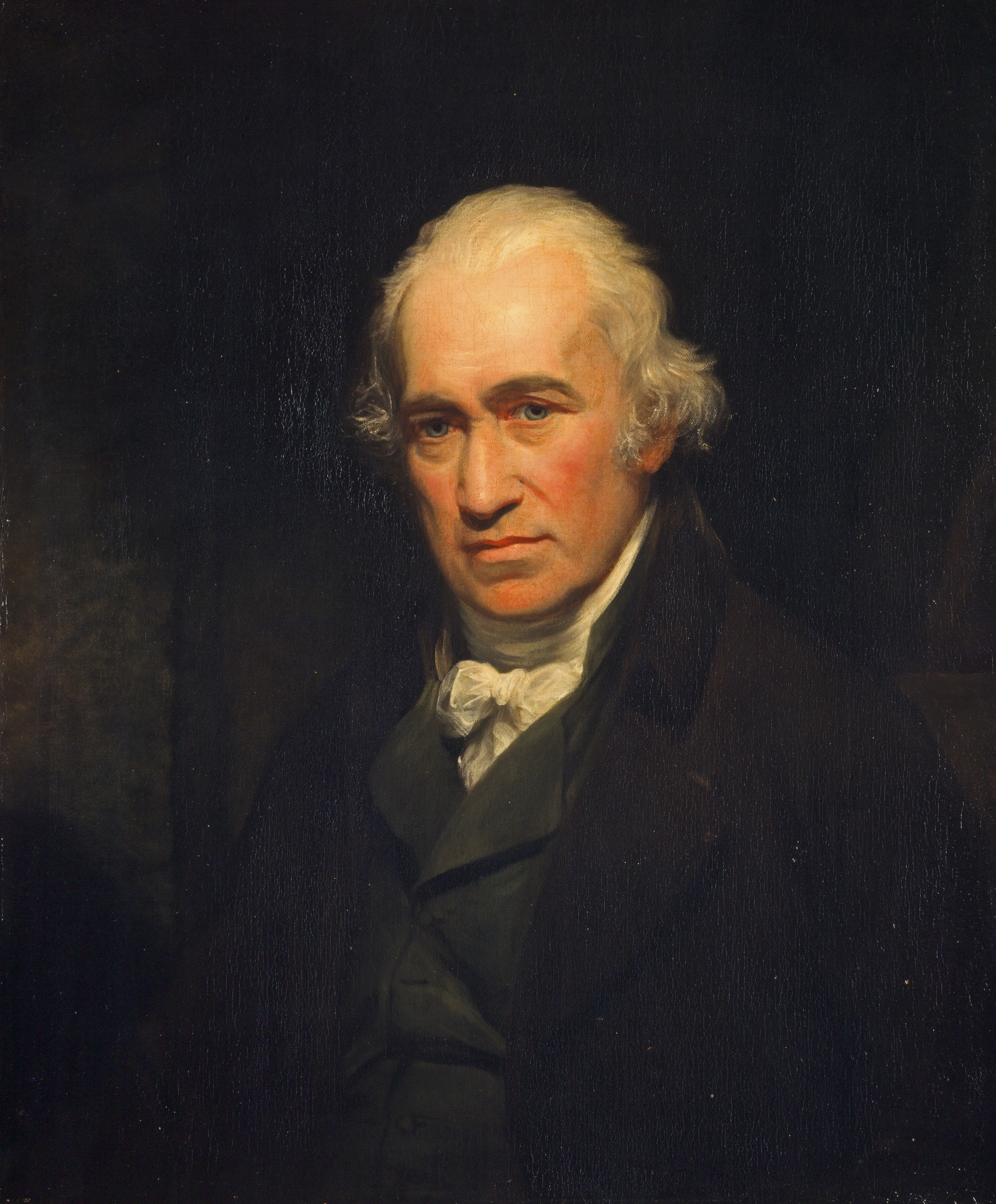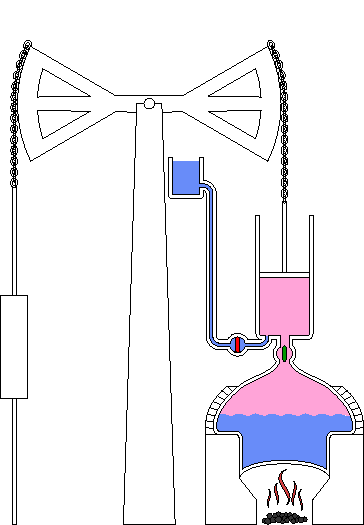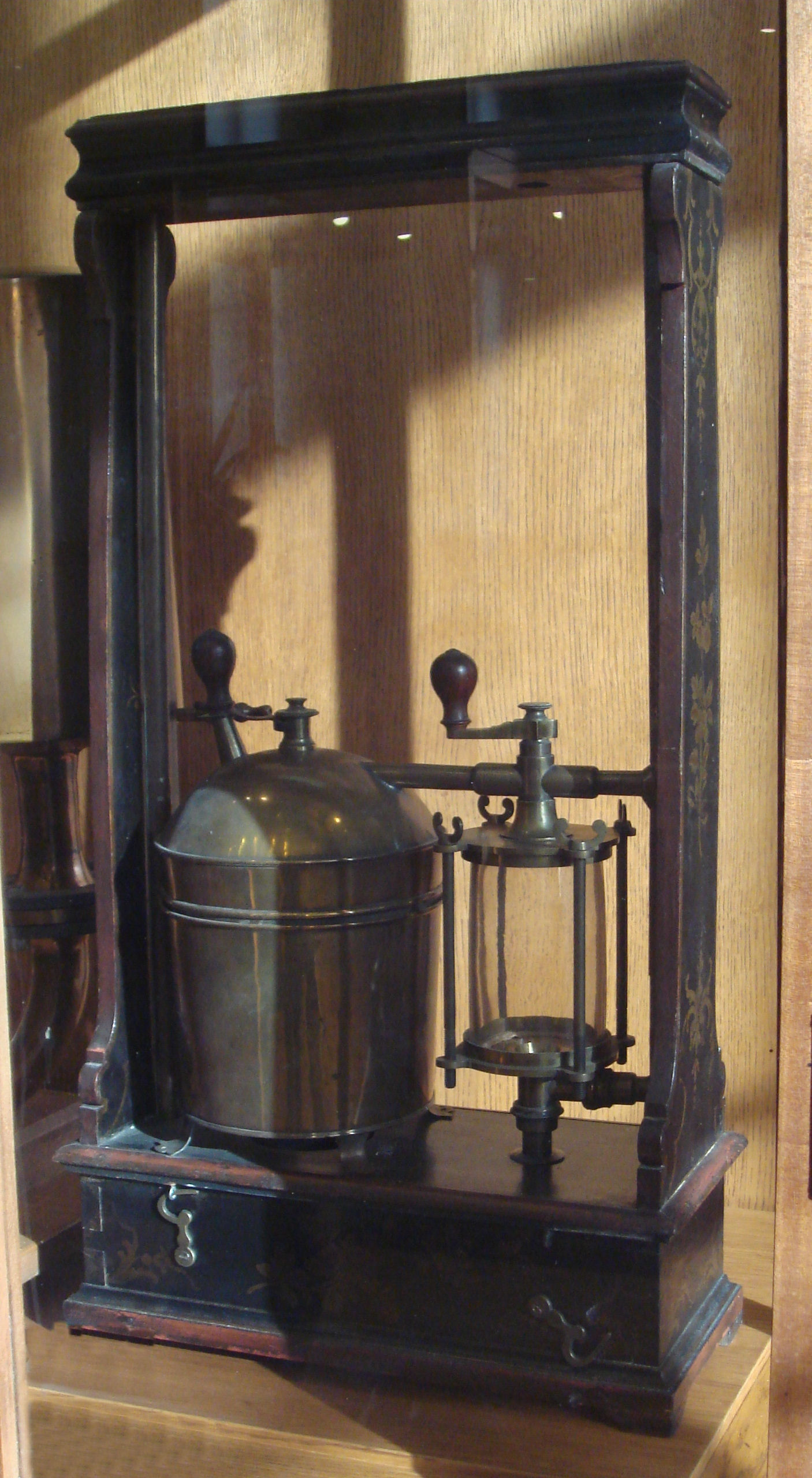|
Steam-engine
A steam engine is a heat engine that performs mechanical work using steam as its working fluid. The steam engine uses the force produced by steam pressure to push a piston back and forth inside a cylinder. This pushing force can be transformed by a connecting rod and crank into rotational force for work. The term "steam engine" is most commonly applied to reciprocating engines as just described, although some authorities have also referred to the steam turbine and devices such as Hero's aeolipile as "steam engines". The essential feature of steam engines is that they are external combustion engines, where the working fluid is separated from the combustion products. The ideal thermodynamic cycle used to analyze this process is called the Rankine cycle. In general usage, the term ''steam engine'' can refer to either complete steam plants (including boilers etc.), such as railway steam locomotives and portable engines, or may refer to the piston or turbine machinery alone, as ... [...More Info...] [...Related Items...] OR: [Wikipedia] [Google] [Baidu] |
Steam
Steam is water vapor, often mixed with air or an aerosol of liquid water droplets. This may occur due to evaporation or due to boiling, where heat is applied until water reaches the enthalpy of vaporization. Saturated or superheated steam is invisible; however, wet steam, a visible mist or aerosol of water droplets, is often referred to as "steam". When liquid water becomes steam, it increases in volume by 1,700 times at standard temperature and pressure; this change in volume can be converted into work (physics), mechanical work by steam engines such as reciprocating engine, reciprocating piston type engines and steam turbines, which are a sub-group of steam engines. Piston type steam engines played a central role in the Industrial Revolution and modern steam turbines are used to generate more than 80% of the world's electricity. If liquid water comes in contact with a very hot surface or depressurizes quickly below its vapor pressure, vapour pressure, it can create a steam exp ... [...More Info...] [...Related Items...] OR: [Wikipedia] [Google] [Baidu] |
James Watt
James Watt (; 30 January 1736 (19 January 1736 OS) – 25 August 1819) was a Scottish inventor, mechanical engineer, and chemist who improved on Thomas Newcomen's 1712 Newcomen steam engine with his Watt steam engine in 1776, which was fundamental to the changes brought by the Industrial Revolution in both his native Great Britain and the rest of the world. While working as an instrument maker at the University of Glasgow, Watt became interested in the technology of steam engines. At the time engineers such as John Smeaton were aware of the inefficiencies of Newcomen's engine and aimed to improve it. Watt's insight was to realise that contemporary engine designs wasted a great deal of energy by repeatedly cooling and reheating the cylinder. Watt introduced a design enhancement, the separate condenser, which avoided this waste of energy and radically improved the power, efficiency, and cost-effectiveness of steam engines. Eventually, he adapted his engine to produce rot ... [...More Info...] [...Related Items...] OR: [Wikipedia] [Google] [Baidu] |
Steam Turbine
A steam turbine or steam turbine engine is a machine or heat engine that extracts thermal energy from pressurized steam and uses it to do mechanical work utilising a rotating output shaft. Its modern manifestation was invented by Sir Charles Parsons in 1884. It revolutionized marine propulsion and navigation to a significant extent. Fabrication of a modern steam turbine involves advanced metalwork to form high-grade steel alloys into precision parts using technologies that first became available in the 20th century; continued advances in durability and efficiency of steam turbines remains central to the energy economics of the 21st century. The largest steam turbine ever built is the 1,770 MW Arabelle steam turbine built by Arabelle Solutions (previously GE Steam Power), two units of which will be installed at Hinkley Point C Nuclear Power Station, England. The steam turbine is a form of heat engine that derives much of its improvement in thermodynamic efficiency from the u ... [...More Info...] [...Related Items...] OR: [Wikipedia] [Google] [Baidu] |
Aeolipile
An aeolipile, aeolipyle, or eolipile, from the Greek "Αἰόλου πύλη," , also known as a Hero's (or Heron's) engine, is a simple, bladeless radial turbine, radial steam turbine which spins when the central water container is heated. Torque is produced by steam jets exiting the turbine. The Greeks in Egypt, Greek-Egyptian mathematician and engineer Hero of Alexandria described the device in the 1st century AD, and many sources give him the credit for its invention. However, Vitruvius was the first to describe this appliance in his ''De architectura'' (). The aeolipile is considered to be the first recorded steam engine or reaction steam turbine, but it is neither a practical source of power nor a direct predecessor of the type of steam engine invented during the Industrial Revolution. The name – derived from the Ancient Greek, Greek word Αἴολος and Latin word ''pila'' – translates to "the ball of Aeolus", Aeolus being the Greek mythology, Greek god of the air a ... [...More Info...] [...Related Items...] OR: [Wikipedia] [Google] [Baidu] |
Beam Engine
A beam engine is a type of steam engine where a pivoted overhead Beam (structure), beam is used to apply the force from a vertical piston to a vertical connecting rod. This configuration, with the engine directly driving a pump, was first used by Thomas Newcomen around 1705 to remove water from mines in Cornwall. The efficiency of the engines was improved by engineers including James Watt, who added a separate Condenser (heat transfer), condenser; Jonathan Hornblower and Arthur Woolf, who Compound steam engine, compounded the cylinders; and William McNaught (Glasgow), William McNaught, who devised a method of compounding an existing engine. Beam engines were first used to pump water out of mines or into canals but could be used to pump water to supplement the flow for a waterwheel powering a watermill, mill. The rotative beam engine is a later design of beam engine where the connecting rod drives a flywheel by means of a Crank (mechanism), crank (or, historically, by means of ... [...More Info...] [...Related Items...] OR: [Wikipedia] [Google] [Baidu] |
Steam Locomotive
A steam locomotive is a locomotive that provides the force to move itself and other vehicles by means of the expansion of steam. It is fuelled by burning combustible material (usually coal, Fuel oil, oil or, rarely, Wood fuel, wood) to heat water in the locomotive's Boiler (power generation), boiler to the point where it becomes gaseous and its volume increases 1,700 times. Functionally, it is a steam engine on wheels. In most locomotives, the steam is admitted alternately to each end of its Steam locomotive components, cylinders in which pistons are mechanically connected to the locomotive's main wheels. Fuel and water supplies are usually carried with the locomotive, either on the locomotive itself or in a Tender (rail), tender coupled to it. #Variations, Variations in this general design include electrically powered boilers, turbines in place of pistons, and using steam generated externally. Steam locomotives were first developed in the United Kingdom of Great Britain an ... [...More Info...] [...Related Items...] OR: [Wikipedia] [Google] [Baidu] |
Thermodynamic
Thermodynamics is a branch of physics that deals with heat, work, and temperature, and their relation to energy, entropy, and the physical properties of matter and radiation. The behavior of these quantities is governed by the four laws of thermodynamics, which convey a quantitative description using measurable macroscopic physical quantities but may be explained in terms of microscopic constituents by statistical mechanics. Thermodynamics applies to various topics in science and engineering, especially physical chemistry, biochemistry, chemical engineering, and mechanical engineering, as well as other complex fields such as meteorology. Historically, thermodynamics developed out of a desire to increase the efficiency of early steam engines, particularly through the work of French physicist Sadi Carnot (1824) who believed that engine efficiency was the key that could help France win the Napoleonic Wars. Scots-Irish physicist Lord Kelvin was the first to formulate a concise d ... [...More Info...] [...Related Items...] OR: [Wikipedia] [Google] [Baidu] |
Industrial Revolution
The Industrial Revolution, sometimes divided into the First Industrial Revolution and Second Industrial Revolution, was a transitional period of the global economy toward more widespread, efficient and stable manufacturing processes, succeeding the Second Agricultural Revolution. Beginning in Kingdom of Great Britain, Great Britain around 1760, the Industrial Revolution had spread to continental Europe and the United States by about 1840. This transition included going from craft production, hand production methods to machines; new Chemical industry, chemical manufacturing and Puddling (metallurgy), iron production processes; the increasing use of Hydropower, water power and Steam engine, steam power; the development of machine tools; and rise of the mechanisation, mechanised factory system. Output greatly increased, and the result was an unprecedented rise in population and population growth. The textile industry was the first to use modern production methods, and textiles b ... [...More Info...] [...Related Items...] OR: [Wikipedia] [Google] [Baidu] |
Thomas Newcomen
Thomas Newcomen (; February 1664 – 5 August 1729) was an English inventor, creator of the Newcomen atmospheric engine, atmospheric engine in 1712, Baptist lay preacher, preacher by calling and ironmonger by trade. He was born in Dartmouth, Devon, Dartmouth, in Devon, England, to a merchant family and baptized at St. Saviour's Church on 28 February 1664. In those days, flooding in coal and tin mines was a major problem. Newcomen was soon engaged in trying to improve ways to pump out the water from such mines. His ironmonger's business specialised in designing, manufacturing and selling tools for the mining industry. Religious life Thomas Newcomen was a lay preacher and a teaching elder in the local Baptist church. After 1710, he became the pastor of a local group of Baptists. His father had been one of a group who brought the well-known Puritan minister John Flavel to Dartmouth. Later one of Newcomen's business contacts in London, Edward Wallin, was another Baptist mi ... [...More Info...] [...Related Items...] OR: [Wikipedia] [Google] [Baidu] |
Thomas Savery
Thomas Savery (; c. 1650 – 15 May 1715) was an English inventor and engineer. He invented the first commercially used steam-powered device, a steam pump which is often referred to as the "Savery engine". Savery's steam pump was a revolutionary method of pumping water, which improved mine drainage and made widespread public water supply practicable. Career Thomas Savery was born at the manor house of Shilstone, near Modbury, Devon. He became a military engineer, rising to the rank of captain by 1702, and spent his free time performing experiments in mechanics. In 1696 he took out a patent for a machine for polishing glass or marble and another for "rowing of ships with greater ease and expedition than hitherto been done by any other" which involved paddle-wheels driven by a capstan and which was dismissed by the Admiralty following a negative report by the Surveyor of the Navy, Edmund Dummer. Savery also worked for the Sick and Hurt Commissioners, contracting the su ... [...More Info...] [...Related Items...] OR: [Wikipedia] [Google] [Baidu] |
Live Science
Live Science is a science news website. The publication features stories on a wide range of topics, including space, animals, health, archaeology, human behavior, and planet Earth. It also includes a reference section with links to other websites. Its stated mission is to inform and entertain readers about science and the world around them.{{r, mission History Live Science was originally made in 2004. It was acquired by ediaNetwork, later called Purch, in 2009.{{r, purch Purch consumer brands (including Live Science) were acquired by Future The future is the time after the past and present. Its arrival is considered inevitable due to the existence of time and the laws of physics. Due to the apparent nature of reality and the unavoidability of the future, everything that currently ex ... in 2018. Reception In 2011, the '' Columbia Journalism Review''{{'s "News Startups Guide" called Live Science "a purebred Web animal, primarily featuring one-off stories and photo gall ... [...More Info...] [...Related Items...] OR: [Wikipedia] [Google] [Baidu] |
Jerónimo De Ayanz Y Beaumont
Jerónimo de Ayanz y Beaumont (1553 – 23 March 1613) was a Spanish soldier, painter, astronomer, musician and inventor. He pioneered the use and design of the steam engine, as well as mining ventilation systems, improved scientific instrumentation, developed windmills and new types of furnaces for metallurgical, industrial, military, and even domestic operations. He invented a diving bell, patented an immersion suit tested before the court of Felipe III in Pisuerga, on August 2, 1602, and designed a submarine. Biography He was born in Guendulain ( Cizur) (Navarre), the son of Carlos de Ayanz, captain of the Pamplona garrison, and Catalina de Beaumont. He was the second of the male siblings, the eldest being Don Francés de Ayanz, born a year earlier. His mother, Doña Catalina de Beaumont y Navarra, instilled in her children the principles of an education appropriate to her rank. He spent his childhood in the Guenduláin manor until in 1567 he went to serve King F ... [...More Info...] [...Related Items...] OR: [Wikipedia] [Google] [Baidu] |










